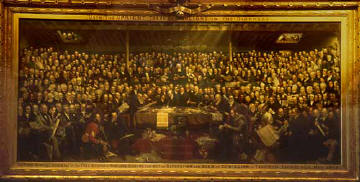|
Church of Scotland and some other churches Brief History |
|
|
1500s |
Scotland's religion was Roman Catholic until John Knox created the reformed Church of Scotland in 1560. The Church of Scotland was a Presbyterian church. In Presbyterian churches, there were no Bishops, and the congregation played an active part in the running of the church and election of Ministers. |
|
This became the Established Church of Scotland in 1567. Establishment meant recognition by the Government as being the official church in Scotland. However, some thought that Establishment had resulted in too much interference by the Government, and they broke away to form new churches. |
|
|
1600s |
The State attempted to introduce Bishops. The Covenanters objected and were persecuted. However, Presbyterianism was restored in 1690. |
|
1700s |
1733 - The Secession Church broke away. 1761 - The Relief Church broke away Both these break-aways occurred when the State introduced new rules for the election of Ministers. |
|
1800s |
1843 - The Free Church of Scotland broke away. This was by far the largest secession from the Church of Scotland, over 400 Ministers leaving the Church. This was the event for which David Octavius Hill took many calotype photos as a basis for his painting. It took Hill several years to take all his photos, and the painting was not completed until 1866. The Disruption: Signing the Deed of Demission - 1843 |
|
1847 - The Secession Church and the Relief Church, the two that broke away in the 1700s, re-united to form the United Presbyterian Church . |
|
|
1893 - The United Presbyterian Church was making moves towards a union with the Free Church. A minority of United Presbyterian members were not happy with this proposed union, so they split to form the Free Presbyterian Church of Scotland |
|
|
1900s |
1900 - The Free Church and United Presbyterian Church united to become the United Free Church However, some of the Free Church of Scotland members did not agree to this union, So they continued as the Free Church of Scotland, known as he "Wee Frees" |
|
1929 - The United Free Church united with the Established Church of Scotland When the Free Church broke away from the Established Church of Scotland, in 1843, it was David Octavius Hill, with a studio at Rock House, Calton Hill, who recorded the event in his painting above. Eighty-six years later, it was Francis Caird Inglis, whose studio was also at Rock House, who recorded the lat General Assembly of the United Free Church of Scotland before the church united with the Established Church of Scotland. The Last General Assembly of United Free Church - 1929 |
|
|
1929 - A minority of the United Free Church did not agree to be united with the Church of Scotland. They were not comfortable with the State-Church relationship. This minority were known as the United Free Church of Scotland (continuing) for the first five years, then as the United Free Church. |
|
|
2000s |
2000 - There was a further split in 2000, when about a fifth of the members of the Free Church broke away to form the Free Church of Scotland (continuing), or FCC FCC Members refer to themselves as 'Continuings' and to Free Church Members as 'Residuals'. This breakaway was not based on doctrine, but on the result of a court case against a prominent United Free Church Member, Professor Donald Macleod. FCC Ministers had supported his prosecution. He was acquitted. Since 2000, there has been an ongoing dispute as to whether the United Free Church or the FCC owns some of the church buildings. The court, in a recent dispute (Skye, August 2009) ruled in favour of the United Free Church. |
|
Acknowledgements: - 1500s to 1999: (a) United Free Church of Scotland web site summary, adapted from an article by Rev A Innes (b) further comments from David King, Granton, Edinburgh. David also provided these links to web sites for various denominations from this page of his Granton History Group web site. - 2000s: A report in The Scotsman, August 9, 2009 |
|
|
Churches in Scotland Summary of break-aways and mergers RED = Official church GREEN = Other churches BLUE = Continuing minority who did not re-unite |
||||||||||
|
NOTE: In order to make it clear which churches
broke away from each other and which amalgamated |
||||||||||
|
Earlier |
1560 |
1567 |
1733 |
1761 |
1843 |
1847 |
1893 |
1900 |
1929 |
2000 |
|
RCC |
RCC |
RCC |
RCC |
RCC |
RCC |
RCC |
RCC |
RCC |
RCC |
RCC |
|
CoS |
ECoS |
ECoS |
ECoS |
ECoS |
ECoS |
ECoS |
ECoS |
ECoS |
ECoS |
|
|
RelC |
RelC |
UPC |
UPC |
UFC |
||||||
|
SecC |
SecC |
SecC |
||||||||
| ECoS | ECoS |
FC |
FC |
FC |
UFC |
UFC |
||||
| FCS | FCS | FCS | ||||||||
| FCC | ||||||||||
| ECoS |
UPC |
FPC | FPC | FPC | FPC | |||||
|
KEY |
|
CoS = Church of Scotland ECoS = Established Church of Scotland FC = Free Church FCS = Free Church of Scotland (continuing) FCS = Free Church of Scotland ('Wee Frees') FPC = Free Presbyterian Church RCC = Roman Catholic Church RelC = Relief Church SecC = Secession Church UPS = United Presbyterian Church UFC = United Free Church |
|
This table and the notes above refer only to the Church of Scotland and a few other churches that have featured in its history. Other religions with less direct connections with the history of the Church of Scotland are excluded - e.g. Methodist, Baptist, Islam, Buddhism, etc. |

